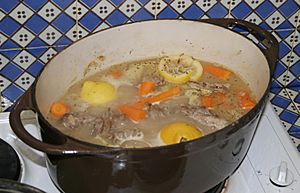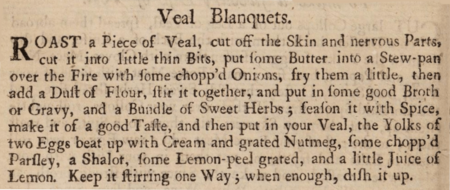Blanquette de veau facts for kids
 |
|
| Type | Stew |
|---|---|
| Place of origin | France |
| Main ingredients | Veal, mirepoix, butter or cream, flour |
Blanquette de veau is a famous French veal stew. It's known for its creamy, white sauce and tender meat. This dish is one of the most loved meat meals in France.
Contents
What is Blanquette de Veau?
A blanquette is a type of stew made with white meat, usually veal. It can also be made with chicken or lamb. The meat is cooked slowly in a light, clear broth. The special part is the sauce, which is made from this cooking liquid. It's then made rich and creamy with cream and egg yolks.
Many people, like famous chefs Simone Beck, Louisette Bertholle, and Julia Child, have called blanquette de veau "a much-loved stew in France." It's so popular that a TV poll in France once put it in the top five favorite meat dishes!
Why is it Called "Blanquette"?
The name "blanquette" comes from the French word "blanc," which means "white." This is a big clue about how the dish should look! The idea is to keep the stew as white as possible.
Some chefs believe that adding colorful vegetables like carrots should be avoided. This is because they might change the white color of the dish. Chef Anthony Bourdain once said:
Even though some cooks like Anne Willan agree with this idea, many other famous chefs, like Auguste Escoffier, have included carrots in their blanquette recipes. So, while the "white" idea is important, some variations exist!
Ingredients and How it's Made
For blanquette de veau, chefs often use cuts of veal that become very tender when cooked slowly. These include parts like the shoulder, breast, or neck.

In older recipes, the veal was sometimes roasted first and then sliced before being covered in the white sauce and reheated. Over time, the way blanquette is made has changed. Today, the meat is usually simmered directly in the white stock until it's very tender.
The sauce is key to a blanquette. It's a type of velouté sauce, which is a classic French "mother sauce." This sauce is made from the cooking liquid of the veal, thickened with a little flour and butter, and then made rich with cream and egg yolks. This gives it its signature creamy, white look and delicious flavor.
Serving Blanquette de Veau
Blanquette de veau is often served with rice. This is a popular side dish because it soaks up the creamy sauce well. However, you can also enjoy it with other vegetables. Some common choices include celeriac, parsnips, leeks, or even braised lettuce. Sometimes, people serve it with pasta or potatoes instead of rice.
See also
 In Spanish: Blanquette de ternera para niños
In Spanish: Blanquette de ternera para niños

